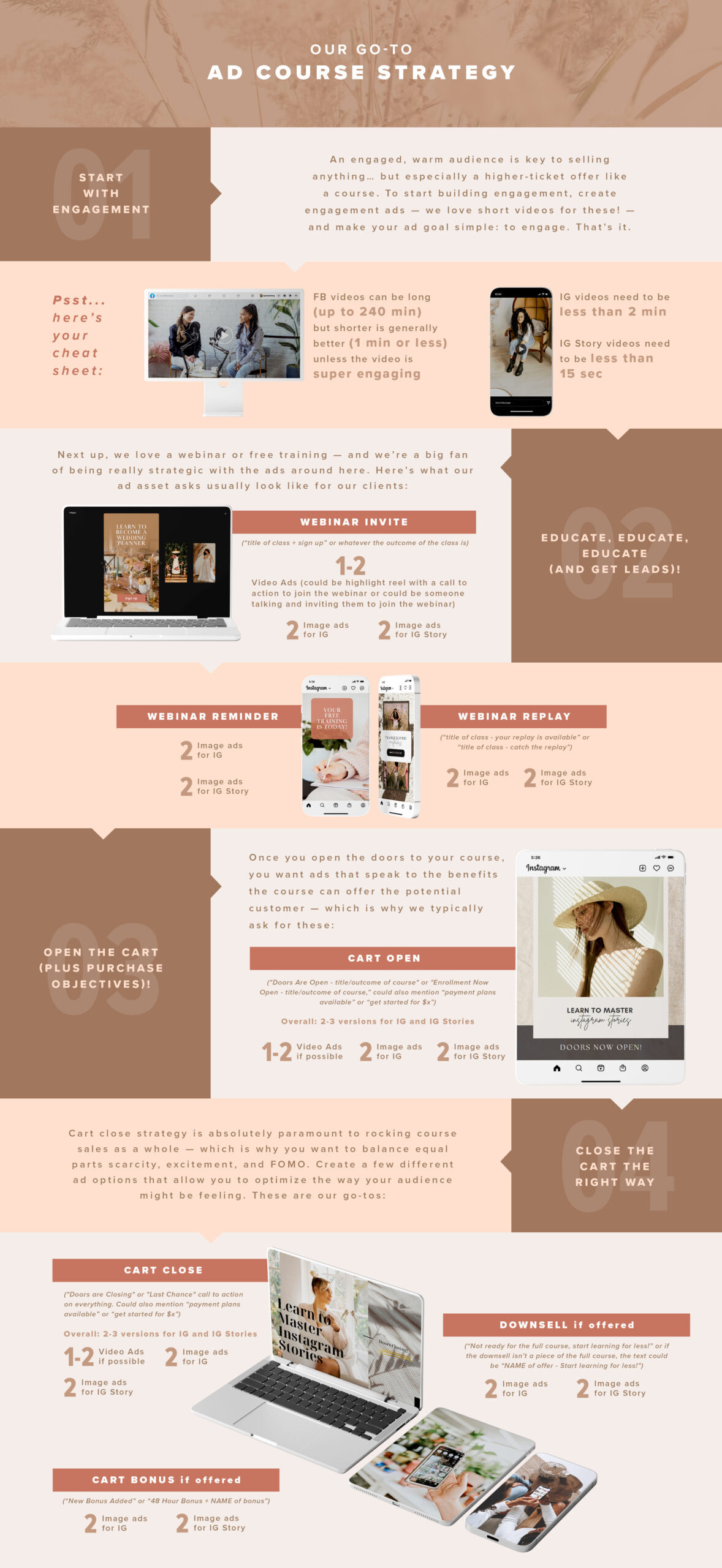We love a good launch over here.
I mean, obviously. 😉
But, really — we’ve handled millions of dollars in ad spend, helped our clients gain millions of dollars back in conversions, and watched as our clients have launched HUGEly successful offers.
#casual.
And, with all of that comes a LOT of learnings, lessons, and best practices for rocking launches with FB ads. So, with no further ado, here are some of our most important tips, questions, and best practices to implement in your next launch!
#1: Focus on your audience, ALWAYS. This is essential for every launch.
Knowing your audience — and approaching them the right way — is almost always at the root of all three of those ways. So, as you start getting ready for your launch and your Facebook ad campaigns, keep that audience in mind over absolutely anything else. Ask questions like this:
- When do they tend to shop the most?
- What messaging is going to attract them?
- What messaging do they hate?
- What have past launches shown you?
- What do their online behaviors show you?
Knowing this is absolutely key to rocking (or, well… not rocking) your launch in the first place.
#2: The seasonality of a launch matters sometimes, but, well… not all the time.
Friends, guess what? You are the one who knows your offer like the back of your hand, and you’re the one who knows your audience. There are tons and tons of offers that do incredibly well no matter the time of year (business owners are always learning!).
However, there are some offers (like… a course on Christmas lights, for instance 😂) that likely aren’t going to perform as well in June as they do in November.
#3: Waitlists work… if you nurture them well.
People have way too many emails in their lists and things on their mind for poorly designed waitlists — AKA, waitlists that don’t nurture, encourage, or remind their audience of what they’re waiting for. However, if you CAN nurture your waitlist, offer them juicy discounts and freebies, and build hype around your offer, you’re killing the game.
#4: Webinar launches have been around for a long time for a reason.
Engagement helps bring lasting connection… and lasting connection is what brings sales. Webinars allow you to build this connection-focused engagement, and people get to see YOU, get to know YOU, and learn from YOU. It’s a powerful, strategic method for introducing yourself, your offer, and your possible outcomes, and it can also scale your launches and help you reach a wider audience.
If you’re hesitant about the webinar style, don’t be — it can be super effective, and there are other ways to frame it! Keep it straightforward and make sure people know what they’re signing up for (we love using mini-sessions, live trainings, and masterclasses messaging), and keep the value first. You can create a challenge, a video series, or a more traditional lunch & learn style webinar, but make sure you don’t middle the message too much.
#5: When you’re building an opt-in page, maximize your opportunity. Include these 10 things:
- Cohesive branding
- Compelling headlines
- The bulk of the message up top (AKA, above the fold!)
- Clear CTAs
- Contrasting colors
- Short form fields (don’t ask too many questions!)
- Zero navigation, please
- Visual clues
- Clarity and brevity — make it easy!
- Your legal I’s dotted and T’s crossed
#6: Utilize past content in your ads!
You do not need to reinvent the wheel with every piece of marketing content you send out, and you certainly don’t need to reinvent the wheel every time you build out a Facebook ad.
The key? Use what’s been well received. It’s that simple. For instance, say you hopped on IG stories recently to talk about something business-related and it sparked engagement! Save the story from your archive and use it as an ad. Say you recorded a video for a course or class a few months ago that seemed to really resonate with your audience. Save the video and use it as an ad.
#7: Remember that your cost-per-lead is unique to you.
Cost-per-lead is not going to be the same across the board (not even close). CPL varies drastically depending on tons of things, like the platform you’re advertising on, your industry, your audience engagement, and your offer itself. Over here, we serve digital course creators and see a CPL lead from between $0.30-$12.00 (depending on all of those factors).
But, no matter what the cost-per-lead IS, we ask ourselves one simple question:
Does it make sense?! AKA, are people actually buying the offer, OR are they being set up to buy an offer in the future?
See, not every lead is going to be a purchaser. So, if you usually see that you need 10 leads for one purchase, that makes a difference — AKA, say your CPL is $10. If your CPL is $10, your cost-per-sale is going to be $100. While that might be a great margin for a really high-ticket course, it’s not going to be a great margin for a $10 guide.
This is also where you have to start thinking about where your leads are going to — are they instantly making a purchase, or are they signing up for your email list in hopes that they’ll make a later purchase? These things matter when it comes to building engaged customers *and* making smart business decisions, too.
#8: You need 3 pieces, or versions, of “creative” for each step in your ad formula. These can be images, videos, Reels, or gifs!
Here’s the formula we use for webinar-style launches to get a little sneak peek:
- Ad/creative #1: Invite!
- Ad/creative #2: Reminder — “Your free class/challenge/etc. is happening today!
- Ad/creative #3: Replay — ”Did you miss it? Catch the replay.”
- Ad/creative #4: Cart open — “Enrollment/doors is/are open!” (this is one where you could test even more than 3 versions of creative)
- Ad/creative #5: Mid-cart bonus (we typically do 2 versions here)
- Ad/creative #6: Cart close — “Doors are closing/time is running out!” (for these, test at least 3 — and try out a testimonial version, too. They can be super powerful in this stage)
- Ad/creative #7: Final day — ”LAST DAY to sign up/enroll!” (we usually shoot for 2 versions here)
#9: The mid-cart part of your launch is SO important — so maximize it with mid-cart bonuses!
When you can optimize that mid-cart phase with tons of value (and bonuses!), you can boost the heck out of your sales. In fact, we’ve seen an increase as big as 30% in sales during the 48-hour mid-cart bonus period. (!!!)
That’s a big boost, huh?!
We recommend mid-cart bonuses to all of our clients, especially to anyone with a longer cart open period. See, when you can add a lil’ bonus round situation to your mid-cart period, you’ll encourage those people who, A) were going to wait until the last minute, or B) were going to forget, to go ahead and lock in their purchase.
Need some bonus inspiration? We recommend checklists, video trainings/exclusive podcast episodes, extra course material, live components, or even a BOGO course offer!
#10: Good ad copy makes ALLLLLL the difference.
To create your launch ad copy, try this easy-peasy formula:
“So… are you ready to change/skyrocket/save [what will be different if they take you up on your offer]? And are you ready to change it NOW?
Imagine [what will they have/accomplish – really paint the picture here for them].
[Offer] is the NUMBER ONE way I/my clients [drive traffic/make money/save time/etc] and you can too!
[Snag/grab/download/other verb] your very own [offer] to [reiterate their goal] and [one more massive benefit]. I promise, my friend, THIS is what you’ve been waiting for.”
—
So, friends, there are 10 MASSIVE lessons we’ve learned over the years for you to take into your own launches! Remember: test, know your audience, and play the long game.
You’ve. Got. This.
Looking for more insights into all things FB ads? Check out our blog here.



















